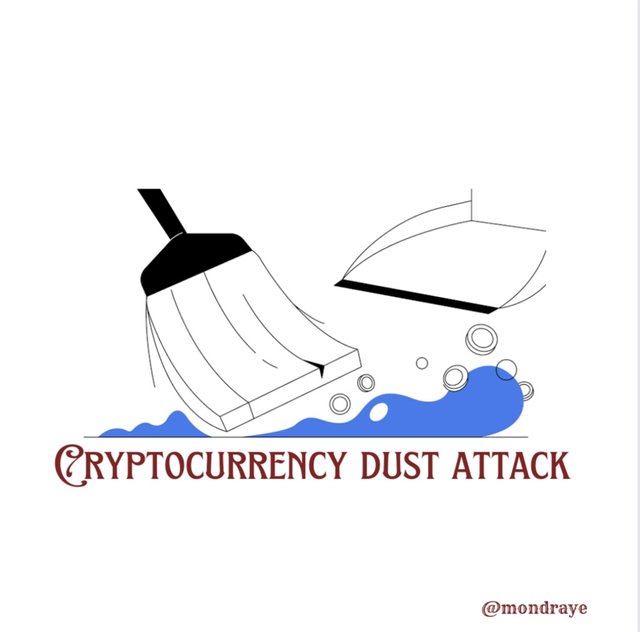CRYPTOCURRENCY DUST ATTACK by@mondraye

Hey guys,
It's been a while since I last posted due to several circumstances far beyond my control. Nevertheless, I am happy to say that I am fully back and ready to ride with you'll harder than I previously did.
There have been series of cryptocurrency hack and attack going on currently which one of those attacks known as wormhole attack on UST is part of the reason we are currently experiencing a general downturn in the entire cryptocurrency market. Today we would be looking at a type of cryptocurrency attack known as dust attack.
A dusting assault is a new type of criminal activity in which hackers and scammers try to compromise Bitcoin and cryptocurrency users' privacy by delivering little sums of funds to their wallets. The attackers then trace the transactional activity of these wallets, using a combination of various addresses to deanonymize the person or entity behind each wallet.

.jpeg)
Dust in cryptocurrency can simply be regarded as an insignificant amount of cryptocurrency. Using Bitcoin as an example, 1 satoshi (0.00000001 BTC) is the smallest unit of BTC, hence we may use the term dust to refer to a few hundreds of satoshis.
Dust is also the name given to small quantities of coins that "get trapped" on users' accounts after trading orders are performed on cryptocurrency exchanges.
There is no official definition for dust in Bitcoin because each software may have a different threshold.
Dust can simply be regarded as any form of out putted transaction that is less that the required gas fee.
The dust limit is defined by the size of the inputs and outputs, which for non-SegWit Bitcoin transactions is 546 satoshis and for native SegWit transactions is 294 satoshis.

Malicious attackers have discovered that cryptocurrency users are unconcerned about the small sums that appear in their wallet addresses. As a result, they began "dusting" a large number of addresses by sending a few satoshis to each of them. After dusting many addresses, the next step in a dusting attack is a combined evaluation of those addresses to see if ones belong to the same crypto wallet.
The final goal is to connect the dusted addresses and wallets to the companies or people who hold them.
If they succeed, the attackers will be able to use this data against their targets, whether through sophisticated phishing attacks or cyber-extortion threats.
Dust assaults were first seen on the Bitcoin network, but they've now spread to Litecoin, Binance Coin, and other cryptocurrencies.
Because dust attack depends on a several-address analysis, attackers won't be able to construct the connections they need to "deanonymize" the wallets if a dust fund isn't moved.

Because Bitcoin is decentralized and open, anyone may create a wallet and join the network without revealing any personal information. Although all Bitcoin transactions are public and transparent, determining who is behind each address or transaction is not always straightforward.
Bitcoin has a level of anominity because they are executed without the assistance of an intermediary, peer-to-peer (P2P) transactions are more likely to remain anonymous. Many crypto exchanges, on the other hand, acquire personal data through KYC verification processes, which means that when users move cash between their personal wallets and exchange accounts, they risk being deanonymized in some way. For each new receiving transaction or payment request, a new Bitcoin address should be created.
Apart from the recently developed dusting assaults, numerous firms, research institutes, and government organizations are doing blockchain analysis in an attempt to deanonymize blockchain networks — and some claim they have already made significant progress.

Cryptocurrency hack attack have grown to be very common with victims drastically increasing. For this reason, we should endeavor to be extra careful in handling our wallets and securing our private keys in other to limit the chances of falling for these hacks.
10% to TRON-FAN-CLUB
To be eligible for #club100, you have to power up all of your earnings & you can't withdraw any amount of STEEM/SBD. The calculation time period is the last 3 months.
Ok
Thank you for the information.
Which club am I eligible for?
Link to tweet
https://twitter.com/SonOfMaaan/status/1531211641668386818?s=19
@Shemul21, please I have corrected the club status to club5050. Can I now get curation on my content please.
I have experienced this and determined that the contents of my trust Wallet were all gone.
I'm so sorry about your loss. I hope the content will help others escape such loss.
This post very important. Thank you for the information.
I am glad you like it.